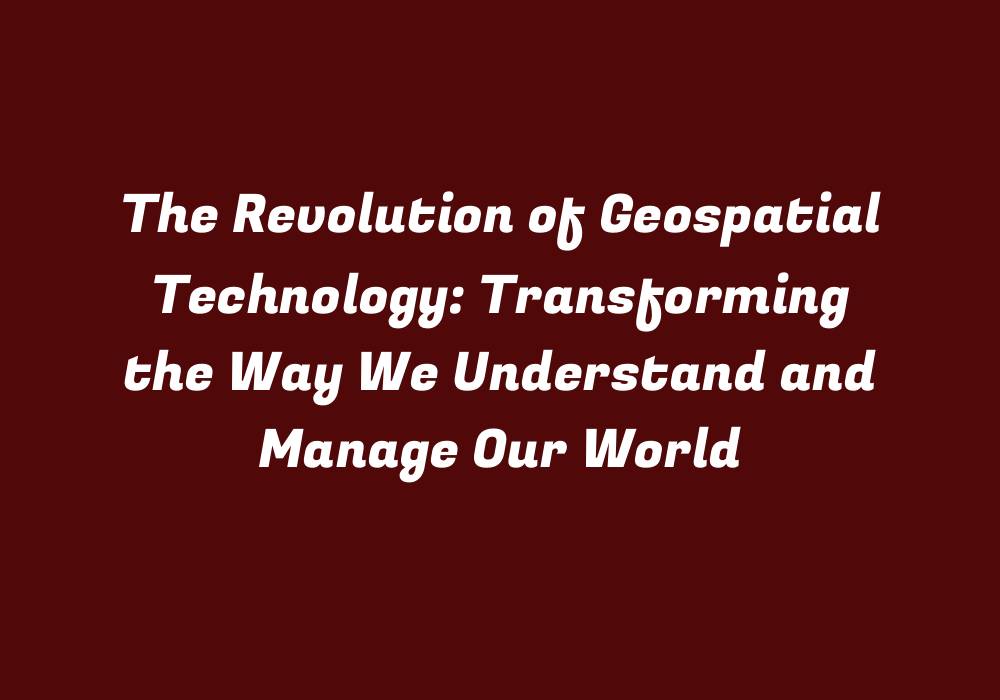Introduction
Geospatial technology has been evolving at a rapid pace, revolutionizing the way we perceive and manage our world. The power to visualize, analyze, and interpret spatial data has become more accessible than ever before, providing us with unprecedented opportunities for understanding and managing various aspects of life. This article will explore this transformation, discussing the benefits it brings across different fields and industries, and highlighting some key examples of geospatial technology applications.
Understanding Geospatial Technology
Geospatial technology is an umbrella term for a range of tools and techniques that work together to acquire, process, analyze, manage, and share data based on location or spatial context. These technologies are often associated with geographic information systems (GIS) and remote sensing applications, which rely on satellite imagery, aerial photography, and ground-based sensors for capturing geospatial data.
Benefits of Geospatial Technology
Geospatial technology has profoundly impacted various sectors in significant ways, as discussed below:
1. **Environmental Management**: By providing a comprehensive understanding of our planet’s ecosystem and resources, geospatial technology plays a crucial role in environmental management. It helps monitor changes in land use, natural habitats, and climate patterns to identify areas at risk of degradation or potential disasters. This, in turn, enables better decision-making for sustainable development and conservation initiatives.
2. **Agriculture**: The agricultural sector has benefitted immensely from geospatial technology, leading to more efficient crop planning, improved irrigation management, and targeted pest control strategies. With precise data on soil properties, weather conditions, and crop health, farmers can optimize their practices and yield better results.
3. **Urban Planning**: Geospatial technology enables better urban planning by providing insights into land use patterns, infrastructure development, and population distribution. This helps city planners make informed decisions regarding the allocation of resources, infrastructure improvements, and community services to enhance overall quality of life.
4. **Disaster Management**: The rapid dissemination of real-time information during natural or human-made disasters is crucial for effective emergency response. Geospatial technology plays a key role in this area by providing situational awareness, enabling the quick allocation of resources, and tracking evacuation routes.
5. **Public Health:** Geospatial data can be used to identify health risks and trends by analyzing the relationships between various environmental factors (such as pollution levels) and disease occurrence. This helps public health authorities prioritize their efforts for improved health outcomes and resource allocation.
6. **Marketing and Business Intelligence:** Organizations use geospatial technology to create customized marketing strategies based on customer demographics, purchasing habits, and location trends. Additionally, businesses can optimize logistics and supply chain management by incorporating spatial data into their decision-making processes.
Key Examples of Geospatial Technology Applications
1. **Digital Mapping:** Digital maps have become an essential component of geospatial technology, providing detailed information on the earth’s surface. These maps can be generated from various data sources, including satellite imagery and ground-based sensors, with accurate positioning made possible through the Global Navigation Satellite System (GNSS).
2. **Unmanned Aerial Systems (UAS) or Drones:** UAS are increasingly being used in a variety of applications, from agricultural surveying to monitoring infrastructure to disaster response and search-and-rescue operations. Their use allows for more efficient data collection and analysis while reducing risks for humans involved in such tasks.
3. **Internet of Things (IoT) and Smart Cities:** By connecting various devices and sensors to the internet, IoT technology enables real-time data exchange, providing valuable insights into urban environments and resource management. This enables cities to become more efficient, sustainable, and responsive to their residents’ needs while fostering a better overall quality of life.
4. **3D Mapping and Virtual Reality (VR):** The advancement of 3D mapping technologies has paved the way for more immersive and interactive experiences in various industries. VR applications, combined with geospatial data, can provide users with a detailed visualization of landscapes, buildings, or other complex environments that would otherwise be challenging to comprehend.
5. **Artificial Intelligence (AI) and Machine Learning:** The integration of AI and machine learning algorithms into geospatial technology has significantly enhanced the capabilities of data analysis and interpretation. These advancements have enabled the development of automated systems for predictive modeling, image recognition, and decision-making to improve efficiency in various sectors.
Conclusion
The revolution of geospatial technology is transforming the way we understand and manage our world by offering innovative tools and solutions across numerous industries. From environmental management to urban planning and disaster response, this rapidly evolving field continues to reshape our approach towards data collection, analysis, and decision-making. As new advancements emerge, the potential for geospatial technology to positively impact our daily lives and ensure a sustainable future remains vast.
